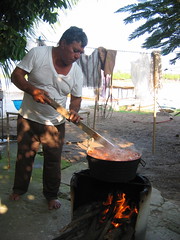
Story by : David Agren
According to legend, the Aztecs once inhabited Mexcaltitan, a small island in Nayarit surrounded by mangroves. They supposedly decamped Mexcaltitan in 1091 for unknown reasons, wandering for more than two centuries until they founded Tenochtitlan in 1325, on two islands in Lake Texcoco; the present site of Mexico City. The Aztecs founded a grand city, the seat of the warrior-tribe's empire, which dominated Mexico until conquistador Hernan Cortes plundered it in 1521.
Modern day Mexcaltitan, which means 'the place of the temple of the moon' in the Nahuatl language, is somewhat less glorious in comparison. Nowadays, shrimp fishermen populate the rustic island, which for the most part lacks paved roads, motor-vehicle traffic and telephone lines. Tall curbs keep the houses and businesses dry during the rainy season, when the San Pedro River floods the island and canoes navigate what passes for Mexcaltitan's main drag, which is aptly named Venecia (Venice). Small lanchas (passenger boats) ferry residents, supplies and more recently tourists to and from the mainland.
Based on the island's history and unique geography, the Mexican Tourism Secretariat dubbed Mexcaltitan a Pueblo Magico (Magic Town), hoping to draw an army of tourists into the remote corner of Nayarit, 108 kilometers northwest of Tepic.
Any journey to Mexcaltitan first passes through Santiago Ixcuintla, a pleasant burg on a coastal plain in the middle of a tobacco-growing region. The lanchas to Mexcaltitan depart from a nondescript point 30 minutes out of town, traveling to the island whenever a combi full of passengers or supplies arrive.
Upon landing in Mexcaltitan, the island's big industry, shrimp fishing, quickly becomes apparent. Shrimp, drying in the hot sun, cover patches of the sidewalks on virtually every block. Fishermen mend nets in front of their homes. Restaurants boast impressive shrimp dishes, ranging from shrimp cocktail to shrimp pate, on their menus. Vendors hawk tamales de camarones (shrimp tamales).
The shrimp boats – humble canoes rigged with outboard motors – head out at night, a time when longtime fisherman Carmelo Estrada said, "The shrimp walk on water."
In a good night, he hauls in 50 kilograms of shrimp, which the next morning he cooks in a large pot with water and salt, turning the delicacy from a dull gray to a bright pink-orange color. He then spreads the shrimp on a concrete patio to dry for two days.
The Pueblo Magico program is supposed to diversify the economy, but shrimp fishing still dominates and tourism amenities are still scarce. One hotel, La Ruta Azteca, operates on the island. A guidebook accurately describes it as "the best, worst and only option." For 150 pesos, a guest receives a single bed, lukewarm water and night in a musty room.
Apparently, the Pueblo Magico program brings also public investment with it, but scarcely any of the money seems to have arrived in Mexcaltitan.
"(The government) sends materials, but nothing gets fixed," lamented Reina Perez, a lifelong island resident. According to a recent Mural article, the federal Tourism Secretariat threatened to revoke the island's Pueblo Magico status if improvements weren't made.
Rumored improvements, which have so far not come to fruition, include painting all of the island's houses white with red trim – a color scheme long used on the island, but according to Perez, for political reasons.
"When the [Institutional Revolutionary Party] PRI was in power all of the houses were painted with their colors," explained Perez, a closet National Action Party (PAN) supporter.
"When the PAN won, people changed the colors."
A team of outsiders spruced up the island – and painted many of the houses – prior to former president Carlos Salinas' visit, the only time anyone remembers improvements being made.
Salinas inaugurated the Museo de Origen, the town's one bonafide tourist attraction. The museum recounts Aztec legends and – no surprise – has a display on shrimp fishing. Beyond the museum, a few seafood restaurants, including one on a neighboring island, might pique a tourist's curiosity.
On the downside, the ubiquitous public drinking is difficult to avoid. Men, sitting on curbs, start chugging caguamas (quart-sized bottles of beer) at the crack of dawn. Bottle caps litter the dirt roads.
Lanchas back to the mainland travel infrequently, making Mexcaltitan a potentially difficult spot to leave. Appropriately, the midday lancha arrives at the mainland in time to meet the Corona beer truck. Some supplies simply can't wait.
From the Guadalajara Colony Reporter


No comments:
Post a Comment